Jyotish, also known as Vedic astrology. This age-old practice has been passed down through generations, offering profound insight into the cosmic forces that shape our lives. Jyotish (or Jyotisha) is the 6th part of the Vedas & its origin can be traced back to the Vedas, the sacred texts of Sanatan Dharma/Hinduism.
Dating back to the Vedic texts of India, Jyotish is more than just astrology – it’s a guide to understanding your purpose, potential, past karma, and path in this world.
Drawing upon the stars, planets, and lunar cycles, Jyotish provides a roadmap for navigating life’s uncertainties and harnessing the universe’s energy. Whether you’re seeking clarity in your relationships, career, or health, this ancient wisdom can illuminate and empower you.
With its roots in the holistic teachings of the Vedas, Jyotish offers a holistic approach to understanding and harmonizing with the natural rhythms of life.
Jyotish – Indian astrology, focuses on the alignment of planets, Nakshatras, and constellations at the time of one’s birth to interpret and understand the individual’s life purpose, traits, and challenges.
However, Jyotish is not restricted to an individual’s life only, it is also used to determine auspicious times for rituals & poojas, to start something new, and to identify the pending karmas.
Also, predicting worldwide events becomes harder as you have to use advanced tools like Sarvato Bhadra chakra and Kota Chakra, etc.
In this blog, you’ll learn a lot about the meaning of Jyotish, the history & origin of Jyotish, how accurate Jyotish is… and much more!
What is Jyotish?
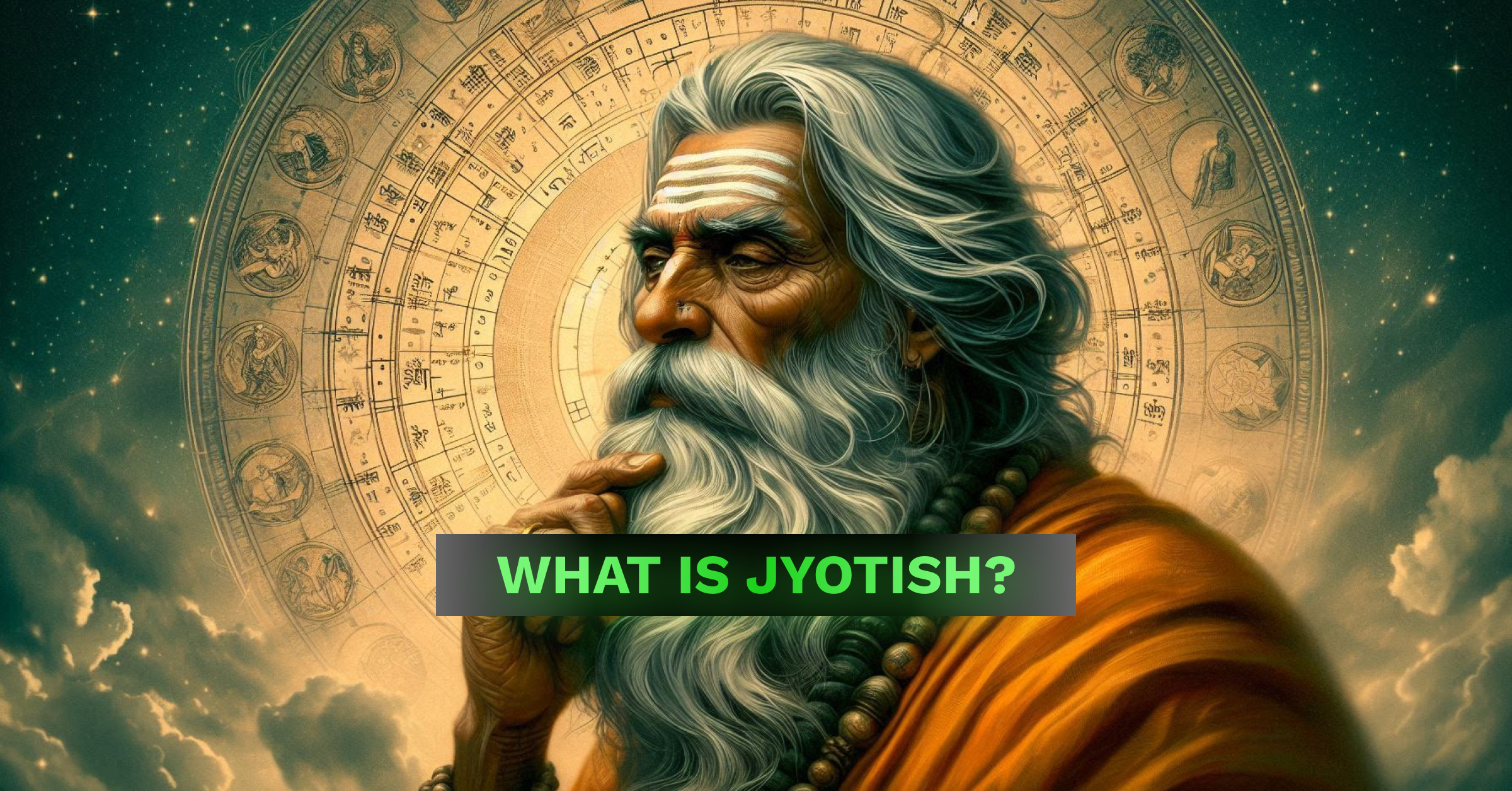
Jyotish is the ancient science of India, it’s the vision of Ishwar that helps you see & understand your karma, the purpose of your soul, your purpose in life, your potential, your future, and much more!
It is a complex, ancient system of divination that is rooted in the Hindu tradition.
It goes beyond just predicting future events and instead provides insight into a person’s karma and dharma.
Karma refers to the actions and events that determine a person’s destiny, while dharma refers to the individual’s purpose and life path.
Jyotish emphasizes the importance of aligning oneself with the natural cycles of the universe and working towards fulfilling one’s dharma.
It is a respectful and holistic approach to understanding the complexities of life and the interconnectedness of all beings.
By studying the movements of the planets (grahas) and stars, Jyotish offers a unique perspective on the paths we choose and the consequences of our actions.
Embracing the principles of this ancient practice can lead to a greater sense of fulfillment and purpose in life.
Jyotish has been a prominent practice in India since ancient times that helps you see through the vision of karma, based on the position of the planets at the time of your birth.
The position of planets at the time of your birth becomes the map of the jeeva (soul), that guides you in understanding your karma, and your purpose in this life. And also answers many questions such as:
- What am I supposed to do in this life?
- Why have I had such a life?
- How can I live my life & fulfill my purpose to the fullest?
And many material questions of life, such as:
- Should I do a job or business?
- When will I get a promotion?
- Why do I face financial trouble & how to reduce it?
- What am I facing health issues & how to get over them?
- Will I ever get married?
- How will be my married life?
- Will my spouse love and care for me?
- I’m facing issues in marriage and don’t want to divorce my spouse, it’s a nightmare I can’t shake! Will my marriage work?
- I’m facing issues with having a child. Will ever be a mother?
- Will I be able to buy my own house?
And so much more!
Jyotish mainly has 2 parts Khagol/Ganit Jyotish(Astronomy) & Falit Jyotish(Astrology).
In Ganit Jyotish all the mathematical calculations are done. And it has 3 parts:
- Siddhant– This is where we calculate the time from the start of this universe to the current day.
- Tantra– This is where we calculate the time from the start of the current Chaturyuga to the current yuga (Kali Yuga).
- Karan– This is where we calculate the time from the current Shak samvat to the current time.
In Falit Jyotish, all the analysis and the study of the positions, and movements of planets, stars, nakshatras, and Rashis(signs) to predict the shubashub likely events, meaning whether good or bad events.
Falit Jyotish also has several parts:
- Hora/Jatak (Natal)– Where Janma kundli is created and Jatak’s/Individuals’ life events are predicted.
- Muhurat (Election)– Where prediction of an auspicious time for a Jatak/Individual or a group of people is done.
- Tajik (Current)– predictions are made after analyzing the transits and Varsh Kundli.
- Prashna (Horary)– kundli is created for the time of the question to make predictions.
- Maidini (Mundane)– Where predictions of Interstate, National, and International level & weather, Earthquakes & worldwide events are done.
- Sahita (Meteorological)– Predictions of Samvat, Changes in Nature, & Samudrik Shastra(Palmistry), etc.
And more!
What does Jyotish mean?
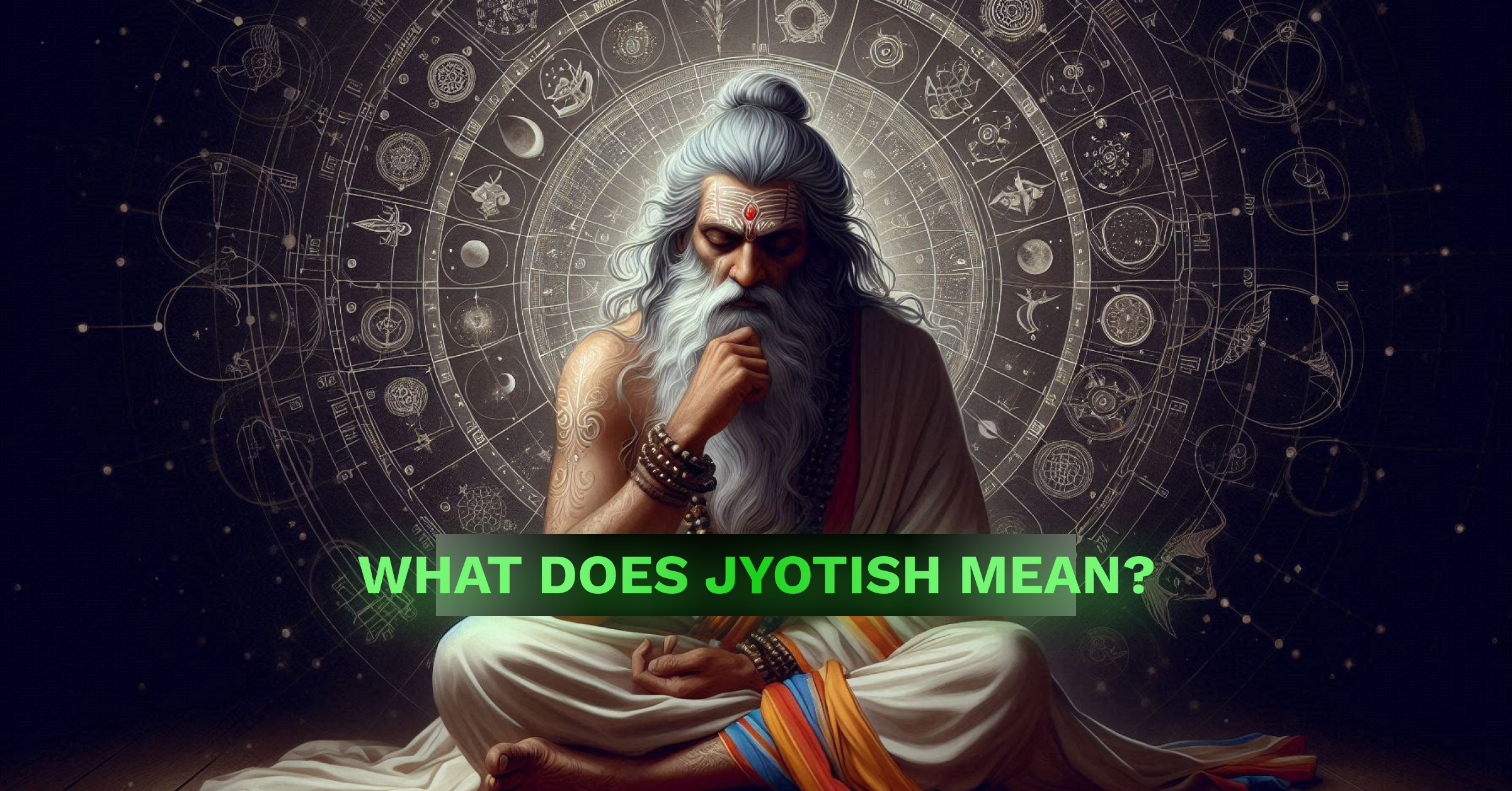
The term “Jyotish” itself is derived from Sanskrit, where “Jyoti” means light and “ish” means Ishwar/lord or god, thus translating to “science of light” or “eye of the Vedas”. This profound astrological tradition is deeply rooted in the Vedic scriptures and is considered one of the six Vedangas, or limbs of Vedic wisdom.
Jyotish also known as Vedic Astrology in India and around the globe, goes beyond mere prediction of future events; it is a holistic approach to understanding the intricate connections between celestial movements and terrestrial life, offering insights into your karma, dharma, and spiritual path.
Jyotishis or Vedic astrologers can guide you in various aspects of life, including a deep understanding of your past, present karma, personality traits, relationships, career, and spiritual growth, and more!
Jyotish is the ancient science of India. An age-old practice has been passed down through generations, from gurus to shishyas, and offers profound insight into the cosmic forces that shape our lives and global events.
Using the position of planets at the time of your birth, Astro software calculates and produces your Birth chart – A natal chart also known as Kundli in Sanskrit and Hindi.
There are 12 houses in a birth chart and Jyotish has 3 styles of charts, you’ll learn more about them a bit later.
Is Jyotish accurate?
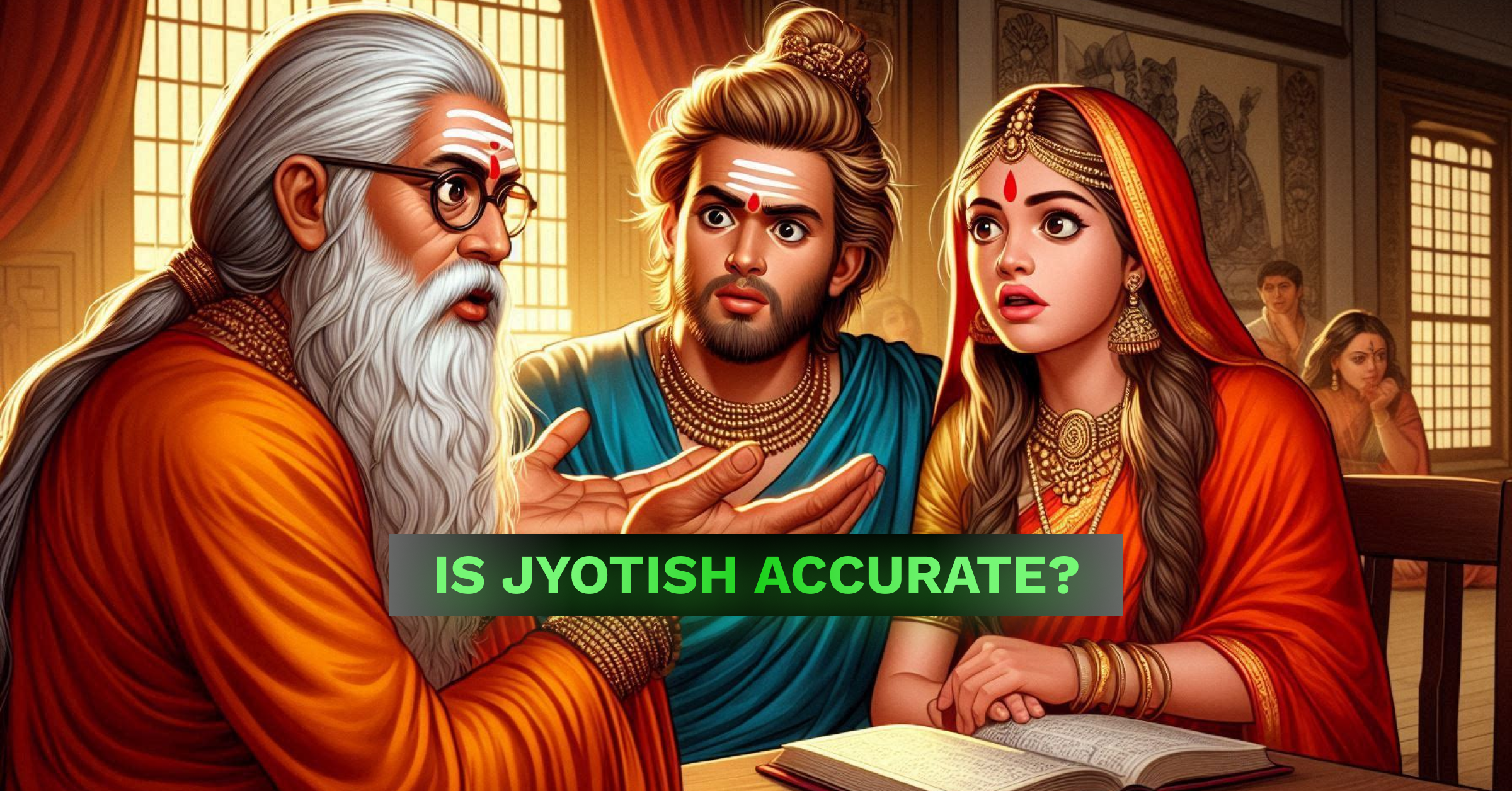
Jyotish as an ancient wisdom, science, or tool is 100% accurate. If a Jyotishi is knowledgeable, learned, and has good experience and research, then you’ll even get goosebumps with Jyotish accuracy.
Do you know how Jyotishis make accurate predictions??
By learning the Jyotish principles, yogas, and rules, and applying those principles to tests in many horoscopes through research, Jyotishis can make accurate predictions. This takes time but with time consistency, and passion Jyotishis’ can put this wisdom to great accurate use.
However, due to lack of knowledge of principles, lack of careful observation, and impatience while analyzing horoscopes, a Jyotishi could fail and end up damaging his/her reputation.
And yes, Jyotishis are also human, so they could make mistakes during their calculations.
However many query seekers are impatient, and curious, leading them to rush the analysis. This leads Jyotishi to fail to make an accurate prediction, which unfortunately hurts the reputation of Jyotish.
Jyotish accuracy is not questionable, it’s the mistakes of the Jyotishi – the astrologer that fails prediction due to miscalculation.
A bit later you’ll learn why Jyotish is the most accurate predictive astrology.
Is Jyotish a true science?
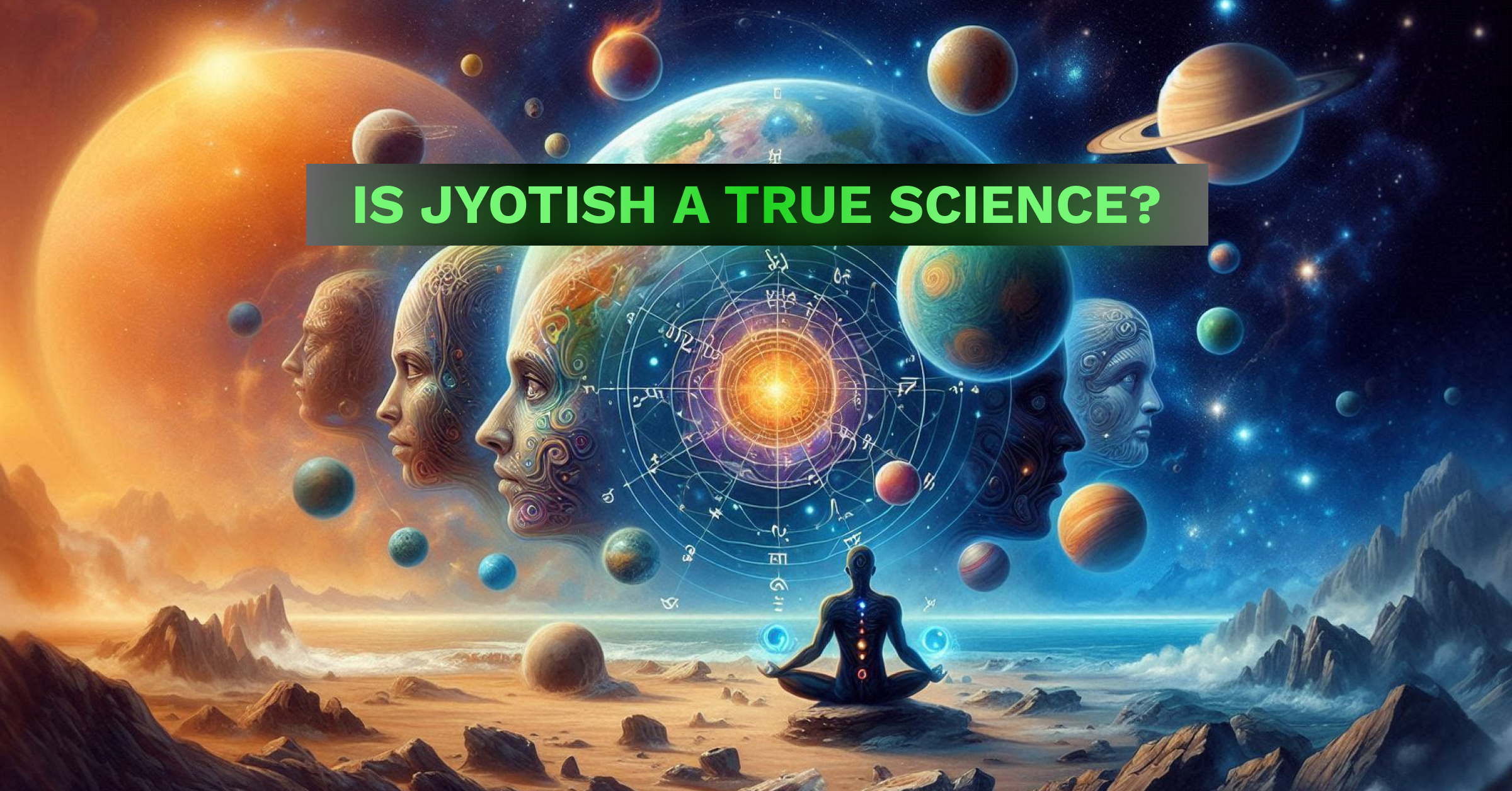
Jyotish is a divine wisdom that was created by Parampita Brahma and later taught to his sons and passed down from generation to generation in Guru-Shishya parampara (tradition). This ancient science has been studied and developed based on the movement of planets for more years than anyone can count.
Despite its critics, Jyotish is not just a science in its own right, but it goes beyond modern science.
Rather than being a mere superstition, Jyotish is based on the study of observation and interpretation of planets and their effects on human affairs.
This raises a big question, “Do planets influence us?” and it is a genuine question.
So what if they do? What if planets influence humans, would you accept it?
Have a look at the following scientific studies that show the influence of planets on humans and the environment.
– This study shows moon has a significant influence on ocean tides.
– This study shows the influence of moon phases on bipolar patients.
– This study shows the influence of moon phases on Schizophrenia patients.
– This study shows the influence of moon phases on homicide.
– This study shows the influence of moon phases on the sleep cycle.
– This study shows the influence of moon phases on strokes.
– This study shows the effects of moon phases on acute coronary.
– This study shows the effects of moon phases on aneurysmal rupture.
– This study shows the influence of solar eclipses on microbes and humans.
Now these studies, show that it’s not about whether planets influence us or not, or is astrology real or not.
It’s about the lack of research and studies on this matter. This is why Jyotish is considered to be a valuable tool for understanding ourselves and the world around us.
When approached with an open mind and a spirit of inquiry, Jyotish can be a powerful tool for personal growth, self-discovery, and so much more.
By looking at the unique position of the stars and planets at the time of our birth, we can gain a deeper understanding of our strengths and challenges, as well as insight into our relationships and life paths.
Ultimately, what makes Jyotish so valuable is its ability to offer us a new perspective on ourselves and the world, helping us to navigate life’s journey with greater clarity and purpose.
In short, Jyotish is not only a fascinating subject but also a bona fide science that deserves our respect and attention.
The History & Origin Of Jyotish
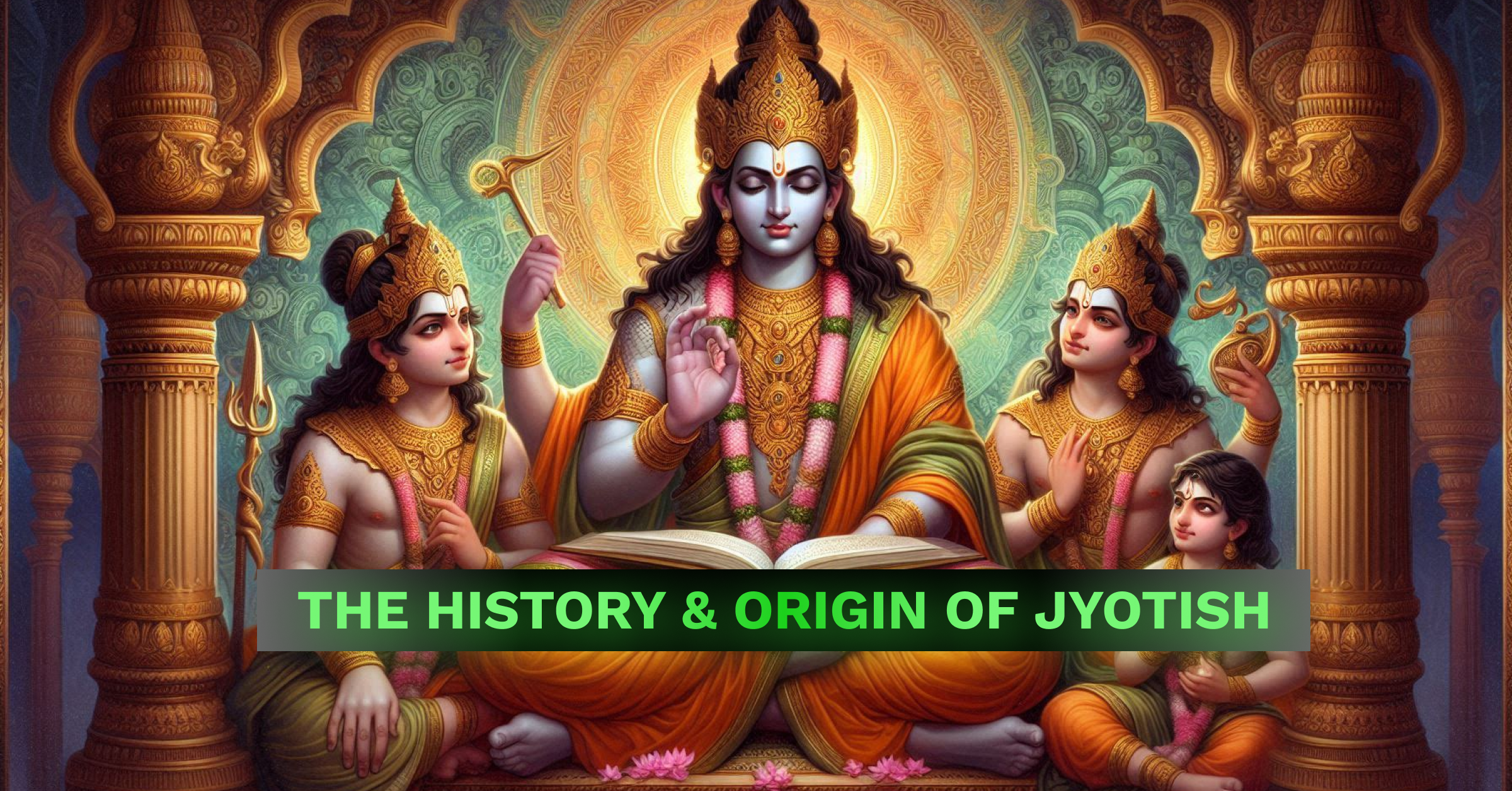
Let’s talk about the history of Jyotish, without being biased.
To know about the history & starting of Jyotish, you should consider calculating time using the ways of Vedic ways itself.
Jyotish also known as Hindu astrology or Vedic astrology, has its roots in ancient Indian culture.
Jyotish is a divine wisdom created by parampita brahma and was later taught to his sons. It have been developed over time by sages thousands of years ago, who recorded their insights and observations in the Sanskrit language.
Rig Veda, dating back to the 2nd millennium (1500-1000 BCE) is one of the oldest tests in the world texts that mentions Jyotish.
Another historical evidence of Jyotish is, Vedang Jyotish by Maharishi Lagadha. Dating back to 1400-1200 BCE, it focuses on the calculation of time and the regulation of the calendar based on celestial observations.
And outlines methods for tracking the movements of the sun and moon, which were essential for determining auspicious times for Vedic rituals.
If you read Navgraha Puran, you’ll see the rishis(sages) were already aware of cosmic powers like Surya (Sun) and other Grahas (planets).
And since they were aware, they also worshipped them.
In Jyotish, you worship Surya Dev for his blessings and positive results in your life as a remedy.
Aditi, the Mother of Surya Dev and Wife of Rishi Kashyap, was meditating on the Surya Dev after receiving a boon from Shri Vishnu. This shows that Surya Dev was Worshipped in Satyuga too.
In Treta yuga, Shri Ram’s avatar was born. But only a few people know that Shri Ram’s Father, Maharaja Dashrath faced issues in having children.
As a remedy for having kids, Maharaj Dasharath was recommended to do an Ashwamedha and Putrakamishti Yagya.
This Yagya was performed by Rishi Shringi (who had to be born in Kaliyuga due to a curse & He left his body about 60-70 years ago in Meerut, India).
As a remedy in Jyotish, you can do Anusthan/Yagya/Hawan/Homan for the fulfillment of needs.
In another instance from Treta yuga, Maharaja Dashrath, Father of Shri Ram was advised to worship Shani dev (Saturn). Because of his Gochar/Transit which was harmful to his Rajya/Kingdom Ayodhya.
Then Maharaja Dashrath worshipped Shani Dev to please him and created a stotra for his blessings.
Today that stotra is known as Dashrath Krit Shani Stotra.
Many other facts prove the origin of Astrology is none other than Bharat/India & this is the history of Jyotish – Vedic astrology.
Some people say that astrology’s origin is Greek because the English names of planets are derived from Greek mythology. Or even Mesopotamia.
Like always, this is just an absurd attempt by the influential powers to overrule history & facts.
The spread of this Vedic wisdom – Jyotish all over the globe happened in this order:
-
Bharat/India
-
China
-
Tibet
-
Rome
-
Greece
-
Egypt
-
Iran
-
And the rest.
And of course, throughout time, different cultures made changes based on their beliefs.
Today, Jyotish continues to be an important part of Hindu culture and spirituality. As well as a popular field of study for those interested in divination, karma, and personal growth.
Jyotish is paramount and remains an important part of India’s rich history and cultural heritage.
Is Jyotish a part of the Vedas? Why is it called ancient Vedic astrology?
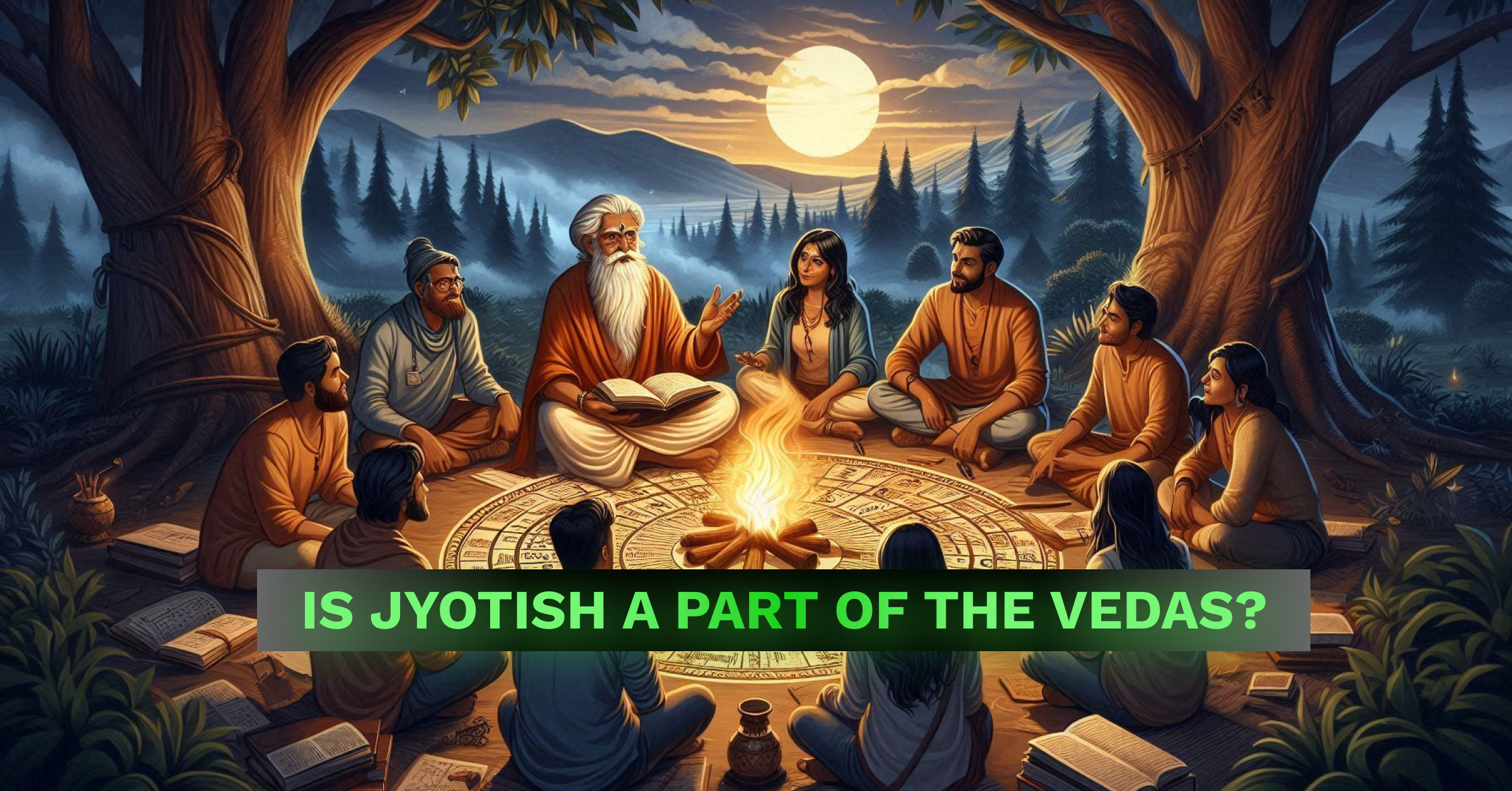
The Narada Puran says Jyotish is one of the 6th Vedangas, limbs of the Vedas. Many other scriptures also talk about Jyotish, some of them are:
- Rig Veda.
- Narad Puran.
- Vishnu Puran.
- Skanda Puran.
- Agni Puran.
- Garud Puran.
- Mundaka Upanishad.
- Chāndogya Upanishad.
- Taittiriya Upanishad.
These and many more Vedic scriptures talk about Jyotish and this is why Jyotish is called Vedic Astrology in the West.
Why Jyotish is the most accurate predictive astrology?
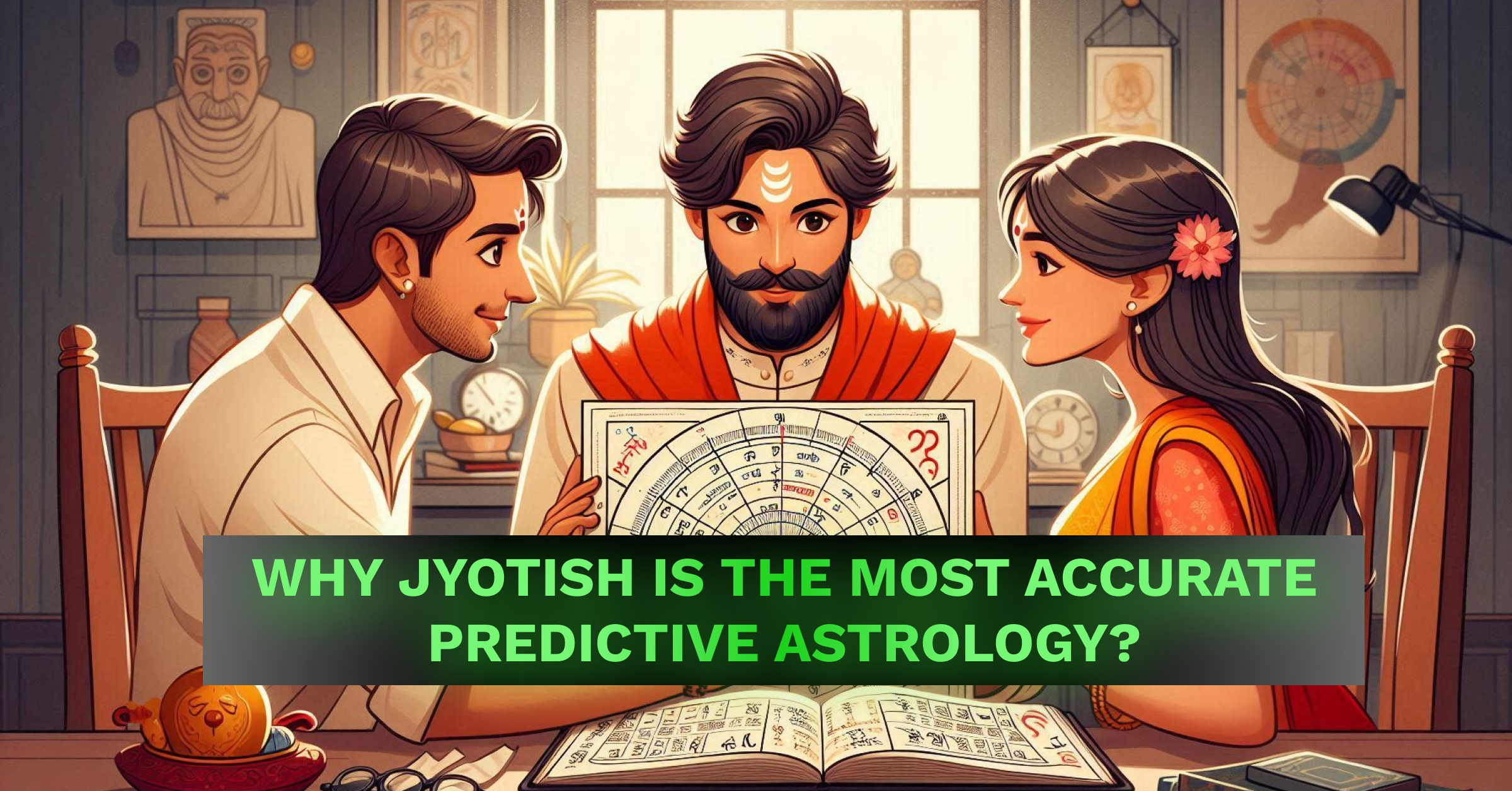
Jyotish is the most accurate predictive astrology because of how calculations are done, the principles, the methodology, and more.
The fundamental difference is in the Zodiac systems.
Tropical vs. Sidereal Zodiac:
Jyotish uses the sidereal zodiac, which is based on the actual positions of the constellations in the sky. This system considers the precession of the equinoxes, leading to a drift in zodiac signs over time, and remains more aligned with the observable planets and constellations, making it more reflective of their true positions.
This is where ayanamsa comes into play.
Whereas others use the tropical zodiac, which is aligned with the seasons and the Earth’s orientation to the sun. This system does not account for the precession of the equinoxes, leading to a drift in zodiac signs over time.
Difference in the chart calculation:
In Jyotish, each house/zodiac of the chart is 30 degrees. Because there are 12 zodiacs in the sky, and you know the sky is 360 degrees. If you divide the 360 degrees by 12 zodiacs = you get 30 degrees for each zodiac.
And when you calculate the nakshatras based on the moon’s position, each nakshatra gets 13 degrees and 20 minutes.
And the difference of ascendent:
At the time of your birth when one certain zodiac is in the east direction based on the position of planets from the place of your birth. This certain sign becomes your ascendant.
Dashas:
In Jyotish, to understand the timing of life events and future events you use dasha. Dasha refers to the planetary periods that are governed by the planets that influence different aspects of life for certain periods.
Although there are many Dasha systems in Jyotish allowing the astrologer to not rely on a single system to make accurate predictions and interpretations. The most widely used dasha systems are:
- Vimshottari Dasha.
- Chara Dasha.
- Yogini Dasha.
- Ashtottari Dasha.
- Shodashottari Dasha.
- And the Kaal Chakra Dasha – father of all dashas, the most advanced and accurate.
Vimshottari dasha is the most widely used dasha system and it can help make accurate interpretations and predictions if an astrologer is knowledgeable. This system consists of nine major planetary periods, known as Mahadashas, with a total lifespan of 120 years. Each planet has a specific duration:
- Ketu: 7 years
- Venus: 20 years
- Sun: 6 years
- Moon: 10 years
- Mars: 7 years
- Rahu: 18 years
- Jupiter: 16 years
- Saturn: 19 years
- Mercury: 17 years
Each Mahadasha is further divided into sub-periods called Antar-Dashas (or Bhuktis), which allow for a more detailed examination of the influences during the Mahadasha. The Antar-Dashas run in the same order as the Mahadashas and are proportional in length to the Mahadasha they belong to.
Furthermore, antar dasha is divided into very short periods called pratyantar dasha, sooksham dasha, and pran dasha being the most narrowed period.
The ruling planet of the Mahadasha influences the themes and experiences during that period. A Mahadasha can lead to growth and success, and challenges may bring obstacles and setbacks – depending on the positions & conditions in your birth chart & divisional charts.
Divisional charts:
Divisional charts also known as Varga charts, are deeper & specialized charts that provide detailed insights into specific areas of life. Divisional charts are derived from the main birth chart and they allow best astrologers to analyze deeper and specific aspects of life with greater precision.
Maharishi Parashar introduced many varga schemes that go to really advanced and deeper levels, but here are some of the known divisional charts:
- D1 Birth chart/Rasi Chart/ Natal chart.
- D2 Hora chart
- D3 Drekkana chart
- D4 Chaturthamsha chart
- D7 Saptamsha chart
- D9 Navamsha chart
- D10 Dashamsha chart
- D12 Dwadashamsha chart
- D16 Shodashamsha chart.
- D30 Trimshamsha chart
- D60 Shashtiamsha chart
- And many more!
The Zodiac, Dasha, and divisional chart systems are just a few of the many things that make Jyotish most accurate.
How to learn Jyotish vidya?

The best way to learn Jyotish vidya is under the proper guidance of a knowledgeable mentor or guru in “Guru-Shishya parampara”. But nowadays finding the right guru is very difficult as there are many charlatans & scammers in this field like every other.
So, you can go ahead to learn & build a strong foundation by reading books by some of the best astrologers I know:
- B.V Raman
- K.N Rao
- V.P Goel
- And many more.
After building a strong foundation, you can go ahead and start reading classic books of Jyotish to further extend your research. And remember to learn the divine wisdom of Jyotish you have to go to its roots!
Ancient India is the source of this great wisdom!
How to read the Jyotish charts? 3 different shart styles of Hindu astrology horoscope
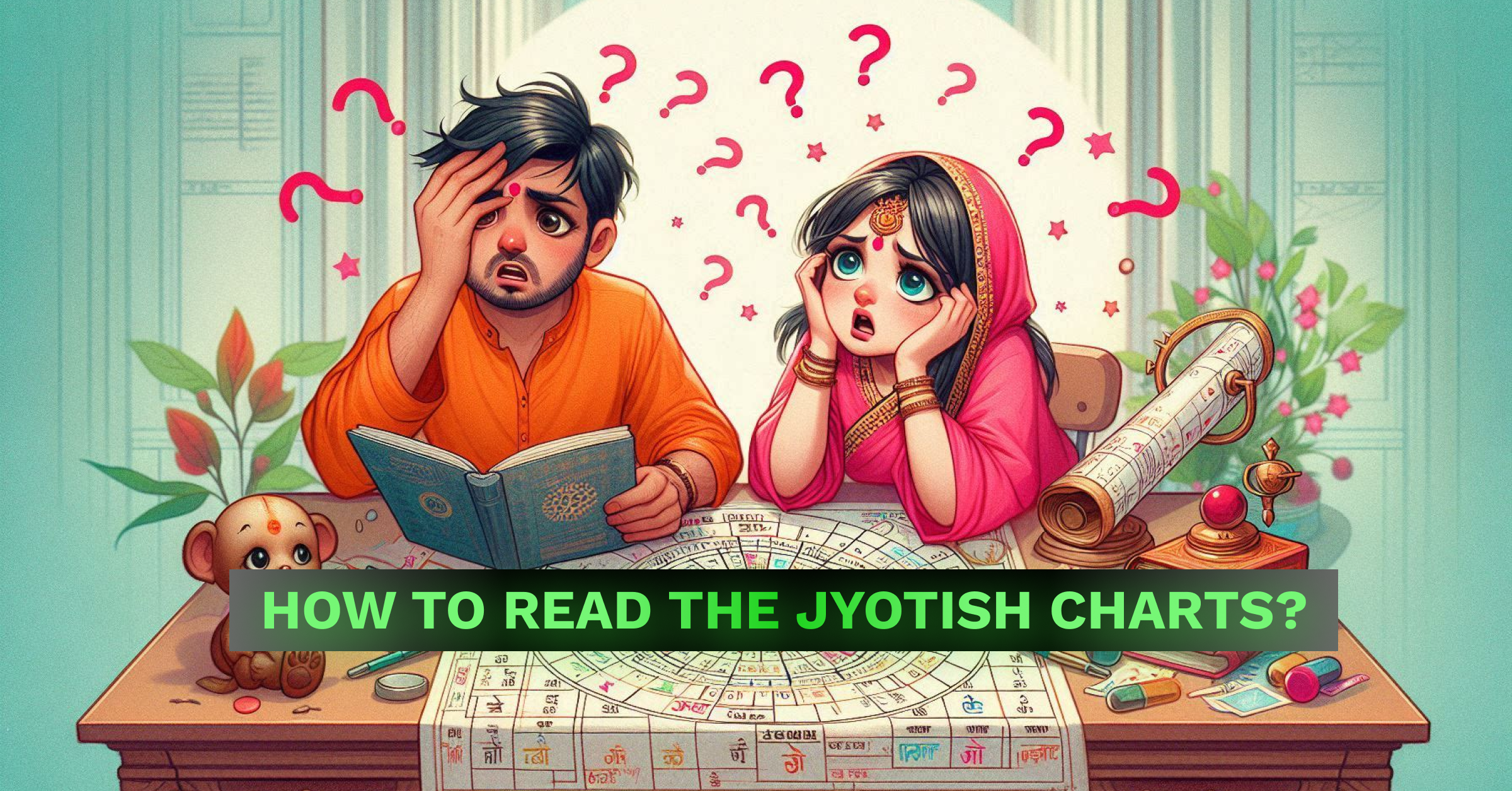
In jyotish, there are 3 styles of birth charts and they are North, East, and South Indian style charts.
In every chart, there are 12 houses, each covering 30 degrees of the horizon, and here’s what each house represents:
- H1(Lagna/Ascendent) – Physical appearance, personality, health, Head, etc.
- H2 – Family, wealth, speech, resources, etc.
- H3 – Courage, younger siblings, short journeys, communication, etc.
- H4 – Mother, home, happiness, comfort, etc.
- H5 – Children, creativity, intelligence, love/romance, etc.
- H6 – Enemies, debts, diseases, sadhana (efforts you make to attain something), etc.
- H7 – Marriage, partnerships, open enemies, masses, people in front of you, etc.
- H8 – Longevity, sudden changes, occult, secrets, transformation, etc.
- H9 – Father, fortune, spirituality, morals, long journeys, dharma, etc.
- H10 – Career, status, father’s health, government, etc.
- H11 – Gains, friends, hopes, desires, elder sibling, etc.
- H12 – Losses, moksha, foreign travel, expenses, investments, hospitals, ashrams, etc.
So now let’s talk about North and East Indian Charts, they are quite similar so let me show you.
North Indian style chart
Look at the picture above.
The first step is to determine the ascendent, lagna which is the sign on the eastern horizon at the time of your birth from your place of birth. In the picture, you can see where the lagna is always located – H1.
And the rest of the houses go in “anti-clockwise” order. This order stays the same throughout the Varga charts too.
The second step is to identify the zodiac signs in the house. The 12 zodiac signs are:
- Aries (Mesh) – Mars
- Taurus (Vrishabh) – Venus
- Gemini (Mithun) – Mercury
- Cancer (Karak) – Moon
- Leo (Simha) – Sun
- Virgo (Kanya) – Merucry
- Libra (Tula) – Venus
- Scorpio (Vrishchik) – Mars
- Sagitarrius (Dhanu) – Jupiter
- Capricorn (Makar) – Saturn
- Aquarius (Kumbh) – Saturn
- Pieces (Meen) – Jupiter
You have to memorize the series of the zodiac so you know what sign each number represents. For example, if there’s no. 1 in the lagna – it means Lagna is ruled by Aries.
Now, look at this picture. here you can see houses in the chart also have the initials of the zodiac signs.
This shows each house of 30 degrees covers a zodiac sign.
Interpret the Planets
The planets in the birth chart represent different energies and influences
- Sun: Ego, father, authority, royalty, government
- Moon: Mind, mother, emotions, comfort, mental state
- Mars: Courage, siblings, energy, aggression, passion, activeness, physical strength
- Mercury: Intelligence, speech, travel
- Jupiter: Wisdom, teacher, expansion
- Venus: Love, beauty, pleasure, luxury
- Saturn: Discipline, delay, obstacles
Look at the sign and house placement of each planet to understand its effects.
Now let’s talk about the East Indian Chart
Look at the picture above, this is what the East Indian chart looks like. Everything else is the same as the North Indian chart.
Now let’s talk about the South Indian Chart
Look at the picture above.
And identify the ascendent/lagna.
In the South Indian chart, you’ll see a line forming a small triangle within a house. Or there will be “Asc” initials of “ascendent” mentioned in the house. This will show your lagna.
Unlike the North or East Indian chart, the order of the house goes in a clockwise motion.
Another important point is, in the South Indian chart the Lagna is not always in a single spot. Whereas, in the North and East chart the lagna is always in a single spot.
And the rest about zodiac signs and planets is the same.
What to do before the consultation of an astrologer?
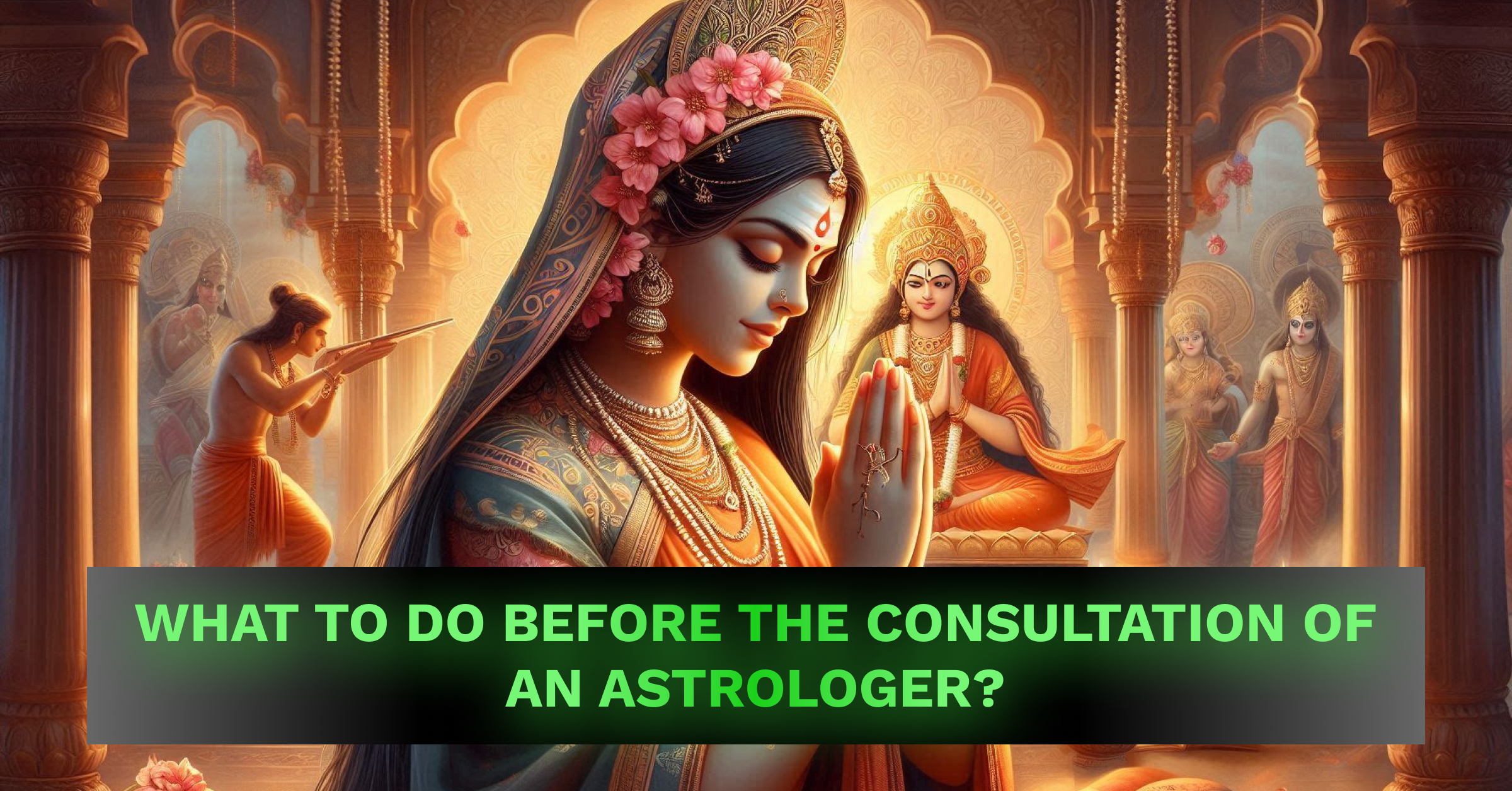
Before you take any consultation from any astrologer make sure he/she is knowledgeable in Jyotish.
One of the best ways to do this is by checking out their content online, and carefully listening to how they talk about Jyotish, and most importantly, you must look for their testimonials & case studies.
After you’ve chosen an astrologer, you should make a list of queries you want to ask, be as clear as you can, and don’t leave anything out for later.
And if you’re not sure about what to ask about, then let me share what one of the best astrologers K. N Rao Ji says.
K. N Rao Ji says you should ask about:
- E – Education
- C – Career
- M – Marriage
- C – Children
- P – Property
- I – Illness
- D – Debt
If you ask any knowledgeable astrologer about these topics, then he/she can surely help you.
Another important thing is to make sure your time of birth is accurate, confirm it by looking at your birth certificate.
And if your birth time is not confirmed or your birth time is 30 mins off then make sure to let your astrologer know.
This is why birth time rectification should be done before you proceed with queries.
What are the astrological planetary periods?
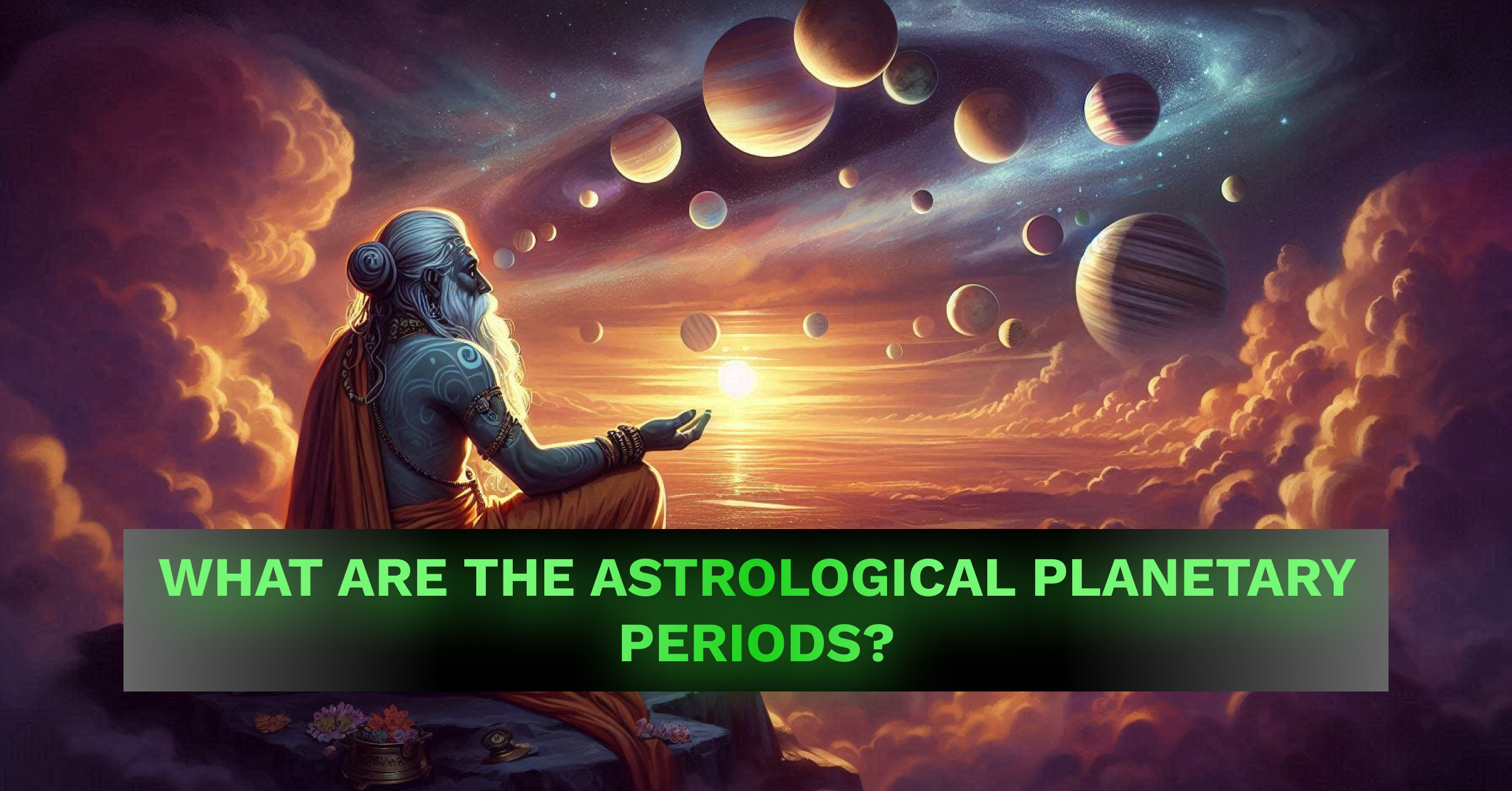
In Jyotish, to understand the timing of life events and future events you use dasha. Dasha refers to the planetary periods that are governed by the planets that influence different aspects of life for certain periods.
Although there are many Dasha systems in Jyotish allowing the astrologer to not rely on a single system to make accurate predictions and interpretations. The most widely used dasha systems are:
- Vimshottari Dasha.
- Chara Dasha.
- Yogini Dasha.
- Ashtottari Dasha.
- Shodashottari Dasha.
- And the Kaal Chakra Dasha – father of all dashas, the most advanced and accurate.
Vimshottari dasha is the most widely used dasha system and it can help make accurate interpretations and predictions if an astrologer is knowledgeable. This system consists of nine major planetary periods, known as Mahadashas, with a total lifespan of 120 years. Each planet has a specific duration:
- Ketu: 7 years
- Venus: 20 years
- Sun: 6 years
- Moon: 10 years
- Mars: 7 years
- Rahu: 18 years
- Jupiter: 16 years
- Saturn: 19 years
- Mercury: 17 years
Each Mahadasha is further divided into sub-periods called Antar-Dashas (or Bhuktis), which allow for a more detailed examination of the influences during the Mahadasha. The Antar-Dashas run in the same order as the Mahadashas and are proportional in length to the Mahadasha they belong to.
Furthermore, antar dasha is divided into very short periods called pratyantar dasha, sooksham dasha, and pran dasha being the most narrowed period.
The ruling planet of the Mahadasha influences the themes and experiences during that period. A Mahadasha can lead to growth and success, and challenges may bring obstacles and setbacks – depending on the positions & conditions in your birth chart & divisional charts.
FAQs
What does Jyotish mean?
The term “Jyotish” itself is derived from Sanskrit, where “Jyoti” means light and “ish” means Ishwar/lord or god, thus translating to “science of light” or “eye of the Vedas”. This profound astrological tradition is deeply rooted in the Vedic scriptures and is considered one of the six Vedangas, or limbs of Vedic wisdom.
Is Jyotish accurate?
Jyotish as an ancient wisdom, science, or tool is 100% accurate. If a Jyotishi is knowledgeable, learned, and has good experience and research, then you’ll even get goosebumps with Jyotish accuracy.
Is Jyotish a true science?
Jyotish is an ancient science of India that has been practiced for centuries. From the perspective of the definition of science, studying Jyotish involves observation interpretation, and experimentation, making it a science in its own right. As with any form of scientific study, there is always room for debate and further research, but it is important to acknowledge the cultural and historical significance of Jyotish in India.
How to learn Jyotish vidya?
To learn Jyotish you can start by building a foundation by reading books by the best astrologers like B. V Raman, V.P Goel, and K. N Rao, etc. And then you can go ahead and read the classic Jyotish books. The best way to learn Jyotish is under the proper guidance of a mentor or Guru.
Is Jyotish a part of the Vedas?
Many Vedic scriptures like Rig Veda, munduka Upanishad, and Chāndogya Upanishad.
Taittiriya Upanishad and many purans talk about the significance of Jyotish. It also mentions that Jyotish is the 6th part of Vedas.

